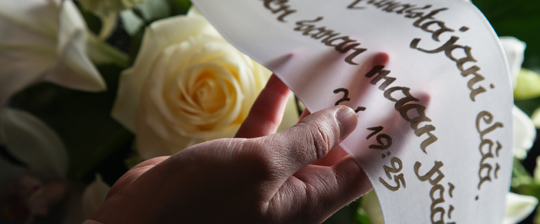|
|

Flower arrangementsIf the deceased has been cremated, flowers are placed on the coffin in the chapel, whereas during burials where the deceased is taken to the grave site in a procession flowers should be placed on the grave, weather permitting. Flowers can be placed on the coffin either at the beginning or at the end of the service. Traditionally, this has taken place at the end of the service, but placing flowers on the coffin at the beginning of the service has become more common in recent years. There are advantages to both customs, so you should discuss the options with the minister. Close family members place their flowers on the coffin first, customarily reading aloud the names and the verse from the Bible or any other suitable greeting given on the ribbons or cards. Even though a few further words can be said as a memorial, any longer speeches are best saved for the funeral reception. The placement of the flowers and pausing by the coffin are the time for a last greeting. Gratitude, memories, and prayers are central to this moment. Silence or reading the greeting or verse from the Bible can be used to convey the prayers. Mourners stay by the coffin for only a moment. After placing their flowers on the coffin, they observe a moment of silence and, turning toward the family, make a small bow of acknowledgement before walking back to their seats. If flowers are placed on the coffin in the chapel even though the deceased is then to be taken to the grave in a procession, people collect their flower arrangements after the final hymn, to take them to the grave. Greetings are not read again beside the grave, the flowers are simply placed on the grave. TFlowers placed on the coffin during a service for a cremation might not be kept until the urn is collected. You should ask what procedure is followed and agree on what should be done with the flowers after the ceremony. |